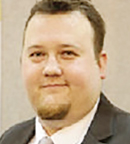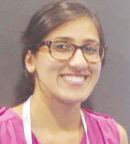A NEW “frailty index” may predict overall survival for patients newly diagnosed with multiple myeloma, according to a study published in JCO Clinical Cancer Informatics.1 Frailty is a critical factor in treatment decision-making for many patients with multiple myeloma, as many of these patients are older at diagnosis. According to the study authors, this tool is the first of its kind to assess frailty based on the accumulation of aging-associated diseases and disabilities—or biologic age—rather than chronologic age alone to predict overall survival in patients with multiple myeloma.

Tanya S. Wildes, MD, MSCI
“Our goal was to create a tool that could be widely applied using data sources at hand and that helps doctors provide better-informed treatment recommendations for their patients,” said the study’s corresponding author Tanya S. Wildes, MD, MSCI, of Washington University School of Medicine, St. Louis. “Our results demonstrate that, for patients with multiple myeloma, chronological age alone is not a good measure for assessing overall health,” she added. Dr. Wildes’ coauthors were Mark A. Fiala, MD, of Washington University School of Medicine, and Hira S. Mian, MD, of McMaster University, Hamilton, Ontario.

Mark A. Fiala, MD

Hira S. Mian, MD
As many as 35% to 40% of patients with multiple myeloma are aged 75 or older. Although new therapies and better supportive care have significantly improved outcomes, an ongoing challenge is distinguishing patients who can safely undergo these aggressive treatments from patients with frailty who would benefit more from less aggressive approaches that preserve their overall health and quality of life.
Federally Funded Study
IN THIS FEDERALLY funded study, researchers analyzed data from more than 2.5 million individuals over the age of 66 who did not have cancer in Medicare Health Outcomes Survey and the Surveillance, Epidemiology, and End Results (SEER)–Medicare Health Outcomes Survey linked databases between 1998 and 2009.
The Medicare Health Outcomes Survey collects self-reported symptoms, functional status, and health-related quality-of-life data annually from Medicare beneficiaries enrolled in Medicare Advantage plans. In the SEER–Medicare Health Outcomes Survey linked data set, data from Medicare Health Outcomes Survey were linked to demographics, tumor characteristics, and survival for those with a cancer diagnosis who resided in the coverage area of the 14 registries participating in the SEER–Medicare Health Outcomes Survey linkage.
Using these data, the authors created a deficit accumulation frailty index made up of a 25-item scale and scoring system. The index includes criteria in five categories for scoring frailty: activities of daily living (ie, difficulty dressing or eating), chronic health conditions, functioning (ie, difficulty walking or climbing several sets of stairs), general health, and mental health. Patients whose scores exceed a certain threshold on the scale are classified as frail.
The index then was applied to 305 patients with newly diagnosed myeloma in the SEER–Medicare Health Outcomes Survey database to predict overall survival.
Key Findings
RESEARCHERS FOUND that for patients with multiple myeloma, age was weakly correlated with a higher frailty score, yet for noncancer patients, an increase in age was strongly correlated with a higher frailty score. Overall, 42% of individuals without cancer were considered frail compared with 52% of the patients with multiple myeloma. The median overall survival of patients who were considered frail was 26.8 months compared with 43.7 months in the nonfrail cohort. Among noncancer patients, each 10% increase in frailty index score was associated with a 40% increased risk for death. Among the patients with multiple myeloma, each 10% increase in the frailty index score was associated with a 16% increased risk of death.
“There’s so much excitement about many new treatment options in myeloma and across cancer, but we must not lose sight of the fact that the cancer is occurring within the body of a unique individual who has unique aging-related issues,” Dr. Wildes said. “What we have to take into account is not only the underlying cancer and approaching its treatment, but also the frailty status of our older patients.”
Next Steps With Frailty Index
THERE ARE several options for optimizing the data in the frailty index, including turning it into a computerized program and examining patients who are not newly diagnosed and have subsequent relapses, disease burden, and treatment toxicities.
The study is limited in the fact that it reported only overall survival and not progression-free survival, chemotherapy toxicity, or hospitalization rates. Additionally, the multiple myeloma population data were derived from patients enrolled in the Medicare Advantage program, which may have contributed to selecting participants who were at overall lower risk due to the way the program incentivizes lower-cost enrollees.
“These findings underscore the need to place more consideration on biological age vs chronological age in multiple myeloma, recognizing that frailty is dynamic and encompasses many factors beyond the disease itself,” said Dr. Wildes. “Ultimately, the hope is that this tool will help us to better personalize care based on a fuller picture of our patients’ health, so we are not undertreating an older adult who can tolerate a more intense therapy or overtreating one who’s going to be vulnerable to the toxicities of therapy.”
Support for this study was provided by National Cancer Institute Grant No. K12CA167540. The Center for Administrative Data Research is supported in part by the Washington University Institute of Clinical and Translational Sciences Grant No. UL1 TR000448 from the National Center for Advancing Translational Sciences, Agency for Healthcare Research and Quality Grant No. R24 HS19455, and National Cancer Institute Grant No. KM1CA156708. ■
DISCLOSURE: Dr. Wildes has received honoraria from Carevive Systems and institutional research funding from Janssen Oncology. Dr. Mian has received honoraria from Celgene and Janssen as well as served as a consultand and/or advisor for Amgen and Takeda. Dr. Fiala reported no conflicts of interest.
REFERENCE
1. Mian HS, Wildes TM, Fiala MA, et al: Development of a Medicare Health Outcomes Survey Deficit-Accumulation frailty index and its application to older patients with newly diagnosed multiple myeloma. JCO Clin Cancer Informatics. July 25, 2018 (published online).

